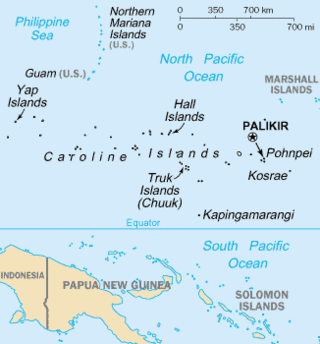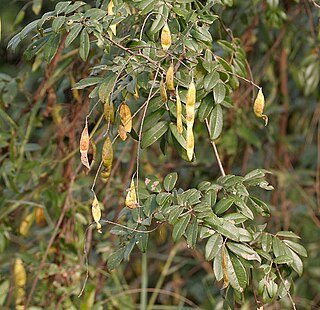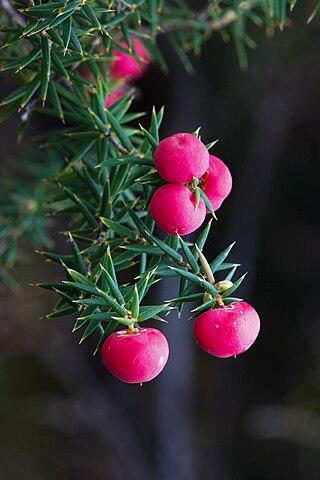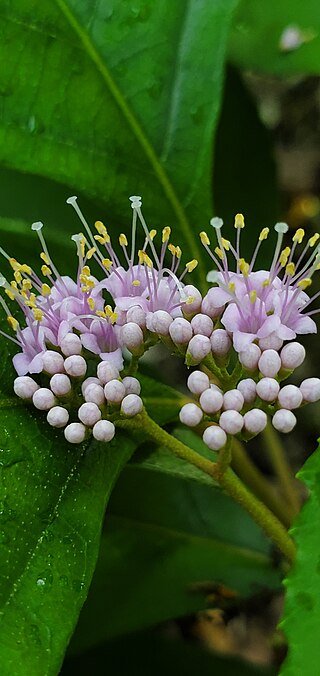
The Caroline Islands are a widely scattered archipelago of tiny islands in the western Pacific Ocean, to the north of New Guinea. Politically, they are divided between the Federated States of Micronesia (FSM) in the central and eastern parts of the group, and Palau at the extreme western end. Historically, this area was also called Nuevas Filipinas or New Philippines, because they were part of the Spanish East Indies and were governed from Manila in the Philippines.

Morinda is a genus of flowering plants in the madder family, Rubiaceae. The generic name is derived from the Latin words morus "mulberry", from the appearance of the fruits, and indica, meaning "of India".

Derris is genus of leguminous plants. It contains 65 species, which range from eastern Africa to the Indian subcontinent, Southeast Asia, New Guinea, northern Australia, and the southwest Pacific islands. The roots of D. elliptica contain rotenone, a strong insecticide and fish poison.

Ochrosia is a genus of flowering plants, first described in 1789. It is in the family Apocynaceae, native to Southeast Asia, Australia, and various islands of the Indian and Pacific Oceans.
Psychotria trichocalyx is a species of plant in the family Rubiaceae. It is endemic to Tahiti, one of the Society Islands.

Leptecophylla is a genus of flowering plants in the Epacridaceae family, a subfamily of Ericaceae. The genus is native to southeastern Australia, New Zealand, Papua New Guinea and the Pacific Islands. Some species in this genus were formerly classified within the genera Cyathodes, Lissanthe, Styphelia and Trochocarpa.
Hedyotis (starviolet) is a genus of flowering plants in the family Rubiaceae. Many species of this genus such as Hedyotis biflora, H. corymbosa and H. diffusa are well known medicinal plants. Hedyotis is native to tropical and subtropical Asia and to islands of the northwest Pacific. It comprises about 115 species. The type species for the genus is Hedyotis fruticosa.

Donella lanceolata is a plant species in the family Sapotaceae. It is a tree growing up to 30 metres (100 ft) tall, with a trunk diameter of up to 40 cm (16 in). The bark is grey to dark brown. Inflorescences bear up to 45 flowers. The fruit are brownish to purplish black, ripening yellow, round, up to 4 cm (2 in) in diameter. Its habitat is lowland forests from sea level to 700 metres (2,300 ft) altitude. Its natural range is Madagascar, India, Sri Lanka, Thailand, Cambodia, Laos, Vietnam, Malaysia, Brunei, Indonesia, the Philippines, Papua New Guinea, the Solomon Islands and Queensland.

Elaeocarpus joga is a species of tree in the family Elaeocarpaceae. It is native to the Mariana Islands and Palau. It is a moderately-sized tree with blue-coloured, round, 1.5cm diameter fruit and leaves which turn bright red before they senescence.

Callicarpa candicans is a species of flowering plant in the mint family. It is native Indochina, southern China, Malesia, New Guinea, northern Australia, and Micronesia.

Cephalomanes atrovirens is a species of fern in the family Hymenophyllaceae. The genus Cephalomanes is accepted in the Pteridophyte Phylogeny Group classification of 2016, but not by some other sources. As of October 2019, Plants of the World Online sank the genus into a broadly defined Trichomanes, while treating the subtaxa of this species as the separate species Trichomanes acrosorum, Trichomanes atrovirens, Trichomanes boryanum and Trichomanes kingii.
Steganthera is a genus of flowering plants belonging to the family Monimiaceae.
Merrilliodendron is a monotypic genus of flowering plants belonging to the family Icacinaceae. It has a synonym of PeekeliodendronSleumer. The only species is Merrilliodendron megacarpum(Hemsl.) Sleumer
Psychotria whistleri, the Rarotonga psychotria, is a herbaceous plant, a member of the Rubiaceae family.

Callicarpa lamii is a plant in the mint family that is endemic to the Mariana Islands. It is one of two Callicarpa plants endemic to the Mariana Islands, the other being Callicarpa candicans var. paucinervia.

Leptecophylla mariannensis is a plant in the Ericaceae family and is only known to exist on the tiny island of Alamagan in the Mariana archipelago.

Hedyotis scabridifolia is an herb or small shrub that is endemic to the volcanic soils of the Mariana Islands of Guam, Rota and Saipan.

Glochidion marianum is a species of plant in the family Phyllanthaceae that is endemic to the islands of Guam and the Caroline Islands.












